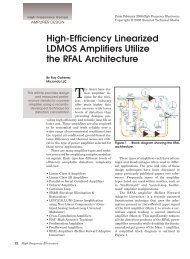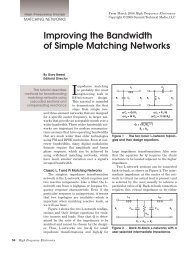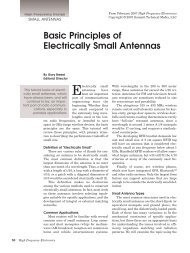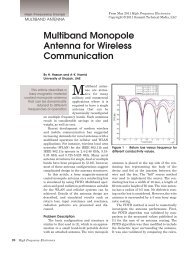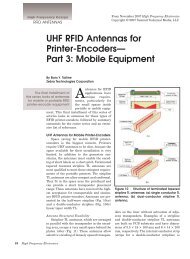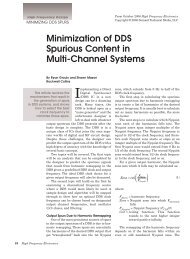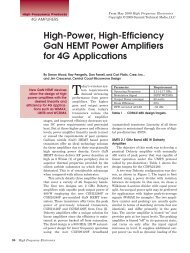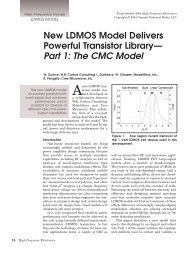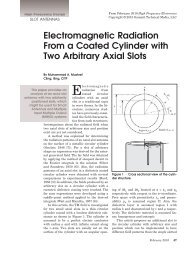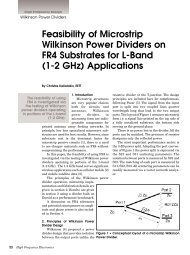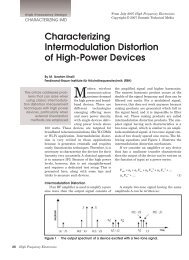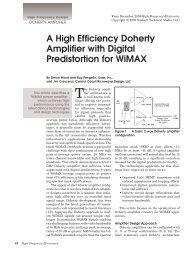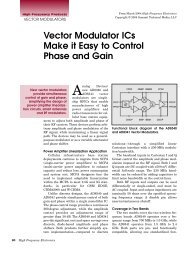Wideband Amplifiers - High Frequency Electronics
Wideband Amplifiers - High Frequency Electronics
Wideband Amplifiers - High Frequency Electronics
Create successful ePaper yourself
Turn your PDF publications into a flip-book with our unique Google optimized e-Paper software.
sient response of the envelope delay the pole pattern is<br />
followed by the use Bessel functions. It is also shown how<br />
important is to choose the staggered poles in multistage<br />
amplifiers instead of repeated poles, particularly when<br />
the gain × bandwidth efficiency is of utmost concern.<br />
In Part 5, the system synthesis and the integration of<br />
components is discussed. This is a well-written self-standing<br />
chapter with good graphics.<br />
In Part 6 are presented the computer algorithms for<br />
analysis and synthesis of amplifier/filters and systems.<br />
In Part 7 are given algorithms and application examples.<br />
The authors are using well known software by<br />
MatLab. A compact disc is included with the book; examples<br />
are worked out in the software.<br />
This book is definitely the best work I have seen in<br />
this particular category. The book is excellent for practicing<br />
engineers, and could also be used as a textbook in post<br />
graduate electrical engineering courses. The professor<br />
who uses it as a text will have to assign his own homework<br />
problems since the book does not include them.<br />
Design of circuits in wireless world, communications,<br />
and the analog design on silicon has become much richer<br />
with the publication of this book. I strongly recommend<br />
that every electronics designer have this book in his or<br />
her personal library.<br />
Reviewed by Anton Mavretic, Ph.D.<br />
Center for Space Physics<br />
Boston University<br />
E-mail: mavretic@bu.edu<br />
Classic Works in RF Engineering<br />
Combiners, Couplers, Transformers and<br />
Magnetic Materials<br />
By John L.B. Walker, Daniel P. Myer,<br />
Frederick H. Raab and Chris Trask<br />
Published by Artech House, 2006<br />
www.artechhouse.com<br />
ISBN: 1-58053-056-7<br />
How often do you wish it<br />
was easier to find a classic<br />
reference, particularly a<br />
technical paper that may be<br />
more than 40 years old? This<br />
problem is especially frustrating<br />
for topics that are not<br />
well-covered in textbooks,<br />
where the collected papers<br />
on the subject are the primary<br />
source of background<br />
information. Here is a book<br />
that solves this problem for<br />
one specific topic—RF transformers, particularly those<br />
using ferrite and powdered-iron magnetic materials, typically<br />
used from low frequencies to UHF.<br />
Fifty-three classic papers are reprinted in this book,<br />
grouped by subtopic. Each chapter includes substantial<br />
introductory material by the authors, followed by the<br />
reprints of pertinent papers. I should note that these<br />
introductions include a list of references beyond those<br />
that are reprinted. The six chapters are:<br />
Chapter 1: Introduction<br />
Chapter 2: Magnetic Materials<br />
This chapter collects hard-to-find data on the characteristics<br />
of ferrite and iron powder magnetic cores, including<br />
composition, permeability, losses, temperature variations<br />
and other parameters. Most of the references are<br />
not well known, except to specialists in this area.<br />
Chapter 3: Baluns/Hybrids/Anti-Phase Power Splitters<br />
Antennas and push-pull amplifiers are good examples<br />
where conversion of a signal between unbalanced<br />
(ground-referenced) and balanced (ground-independent)<br />
sources and loads is required. L-C, transmission line and<br />
transformer-based designs are among the types considered.<br />
Chapter 4: Transmission Line Transformers<br />
This chapter covers broadband impedance matching<br />
using transmission line transformers. In particular, this<br />
chapter addresses topologies, design methods and construction<br />
techniques required to obtain a transformer<br />
with the desired impedance transformation ratio, bandwidth,<br />
loss and power handling capabilities.<br />
Chapter 5: Hybrid Power Combiners and Splitters<br />
The principles of transmission line transformers are<br />
extended to power combining/dividing circuits in this<br />
chapter. The emphasis is on high-power applications,<br />
although the circuits are certainly scalable for small-signal<br />
implementation.<br />
Chapter 6: Quadrature Combiners and Splitters<br />
This more specialized circuit is difficult to implement<br />
in wide bandwidths, but its value in areas such as oddorder<br />
harmonic cancellation in combined power amplifier<br />
systems makes it an interesting topic for many designers.<br />
Some of the reprinted papers are widely-referenced<br />
seminal papers by such authors as Guanella, Ruthroff,<br />
Wilkinson, Pitzalis and Granberg. Others are papers and<br />
journal articles by a variety of authors, many of whom<br />
addressed one specific aspect of the subject. Some of these<br />
papers may be the only published material on their<br />
respective topics.<br />
The subject of this book is one of personal interest,<br />
and I have used many of these circuits in radio and<br />
antenna systems over the past 30 years. I am also gratified<br />
to see that eleven of the papers selected by the<br />
authors were originally published under my direction in<br />
technical magazines and at engineering conferences.<br />
Reviewed by Gary Breed<br />
Editorial Director<br />
<strong>High</strong> <strong>Frequency</strong> <strong>Electronics</strong><br />
From October 2006 <strong>High</strong> <strong>Frequency</strong> <strong>Electronics</strong><br />
Copyright © 2006 Summit Technical Media, LLC<br />
October 2006 61



